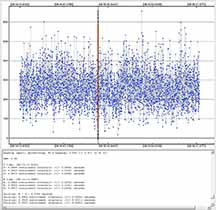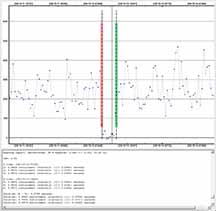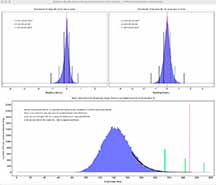

This event slopes from Empire Grade down through deLaveaga Park and Capitola. It's narrow, the asteroid is only 3.18 km across, and the duration is only 0.3s, but the target star is bright enough that we can get it at 2x in a moonless clear sky, or even 1x perhaps (but I'm guessing 2x is needed, at 20 deg altitude. 0.3s is then 15 fields or 7.5 frames for a maximum duration event, and that's quite able to be a solid 5-sigma positive if we can just change our luck from these misses of late.
 |
 |
Kirk and I both got good data. Karl was not in the path and did not observe.
I observed from the cul-de-sac of Monte Rd, cross street "Via Hermosa" in the housing complex south of Granite Creek Rd and just north of Hwy 1. This is a newly discovered (for me) site and I will remember it for future events. It may be better than my Mill Rd site for many events this summer at low southern altitude. Mill Rd southern altitudes must be at least 25 degrees to be do-able.
Skies were clean, clear, dry, and no moon. I chose the 1x (1/50th second) integration setting in hopes of being able to verify even a shorter than 0.3s occultation with enough occulted points to get it past the auditors in IOTA. I analyzed both in frame mode and then again in field mode. The 'frame mode' PyMovie analysis was a mistake to do, given the 1/50s integrations, and so was not analyzed in PyOTE. For the 'field mode' analysis, I get an event that is 0.7 seconds early (but the predicted time is only given to 1s precision, so essentially it is on-schedule, and of most probable duration; 0.28 seconds. However, my first reduction attempt, using TME apertures, finds the event but it only passes at the 3.7 sigma level. I will count on Kirk's data to confirm the event to higher confidence.
Long=122 00 53.62
Lat=36 59 43.13
elev=142 ft
The sky level was clipped. I am wondering if this is really a flaw in any equipment and instead is a flaw in the programming. If the sky is really dark, of course you will not have negative values to complete a Gaussian histogram. I think there's no equipment flaw here, just a limitation of the assumption in the programming that sky values will be Gaussian distributed. Actually, Tony tells me that because the IRE is factory set to =0, and there's no IRE=7.5 option as their is in the NTSC model, that's what causes the clipping. Longer integrations still solve this, but for short and dark sky situations, you'll get clipping and nothing you can do about it.
magDrop report: percentDrop: 87.7 magDrop: 2.278 +/- 0.599 (0.95 ci)
DNR: 2.39
D time: [08:15:12.2618]
D: 0.6800 containment intervals: {+/- 0.0061} seconds
D: 0.9500 containment intervals: {+/- 0.0187} seconds
D: 0.9973 containment intervals: {+/- 0.0687} seconds
R time: [08:15:12.5349]
R: 0.6800 containment intervals: {+/- 0.0061} seconds
R: 0.9500 containment intervals: {+/- 0.0187} seconds
R: 0.9973 containment intervals: {+/- 0.0687} seconds
Duration (R - D): 0.2731 seconds
Duration: 0.6800 containment intervals: {+/- 0.0094} seconds
Duration: 0.9500 containment intervals: {+/- 0.0250} seconds
Duration: 0.9973 containment intervals: {+/- 0.0744} seconds
 |
 |
 |
 |
 |
 |
 |
 |
I tried a second analysis, this time using the 12-set circular apertures. The largest and smallest apertures were clearly the noisiest, and the best looked to be aperture=4, which happens to be my standard default aperture too. This time, I got a much more solid solution, passing the 5-sigma FP test with some room to spare. The timing accuracies look tighter too. The center of the event was 1:15:12.40, or 0.6s earlier than the prediction of 1:15:13, but the prediction is only given to the rounded off nearest second.
magDrop report: percentDrop: 90.7 magDrop: 2.573 +/- 0.872 (0.95 ci)
DNR: 2.66
D time: [08:15:12.2618]
D: 0.6800 containment intervals: {+/- 0.0063} seconds
D: 0.9500 containment intervals: {+/- 0.0174} seconds
D: 0.9973 containment intervals: {+/- 0.0613} seconds
R time: [08:15:12.5418]
R: 0.6800 containment intervals: {+/- 0.0063} seconds
R: 0.9500 containment intervals: {+/- 0.0174} seconds
R: 0.9973 containment intervals: {+/- 0.0613} seconds
Duration (R - D): 0.2800 seconds
Duration: 0.6800 containment intervals: {+/- 0.0089} seconds
Duration: 0.9500 containment intervals: {+/- 0.0223} seconds
Duration: 0.9973 containment intervals: {+/- 0.0621} seconds
 |
 |
 |
 |
I got an event at the predicted time, 2x, star flickering gave noisy results, passed 4 sigma but not 5 sigma.
At first I tried TME, then static 12-stack, found a 2.4 static aperture gave best results, smoothing didn't improve it.
magDrop report: percentDrop: 95.6 magDrop: 3.383 +/- 0.911 (0.95 ci)
DNR: 2.95
D time: [08:15:12.8100]
D: 0.6800 containment intervals: {+/- 0.0065} seconds
D: 0.9500 containment intervals: {+/- 0.0181} seconds
D: 0.9973 containment intervals: {+/- 0.0366} seconds
R time: [08:15:13.0889]
R: 0.6800 containment intervals: {+/- 0.0065} seconds
R: 0.9500 containment intervals: {+/- 0.0181} seconds
R: 0.9973 containment intervals: {+/- 0.0366} seconds
Duration (R - D): 0.2789 seconds
Duration: 0.6800 containment intervals: {+/- 0.0096} seconds
Duration: 0.9500 containment intervals: {+/- 0.0221} seconds
Duration: 0.9973 containment intervals: {+/- 0.0469} seconds
I note that Kirk's timings were 0.55s later than mine. We were several miles apart, but still, this seems a lot, given the diameter of the asteroid was only 0.28s. Oblong shape? Slow mover?
 |
 |
 |
 |
 |